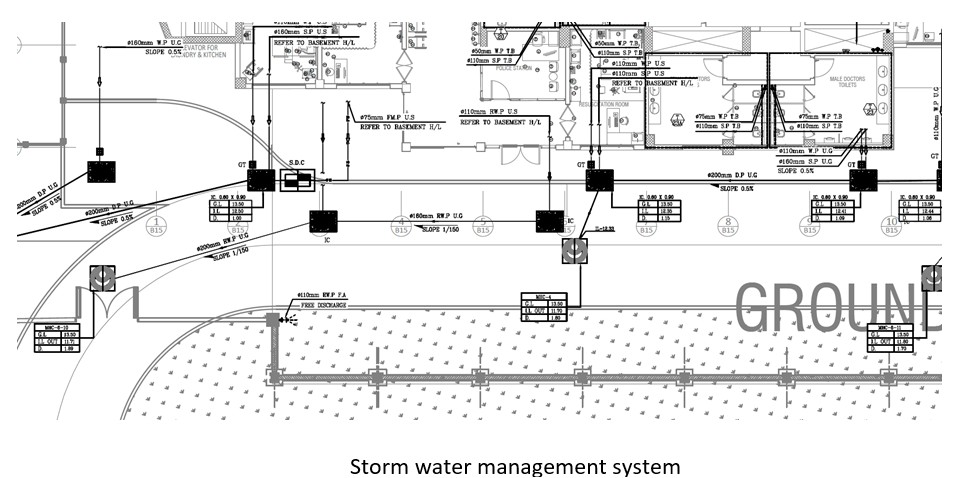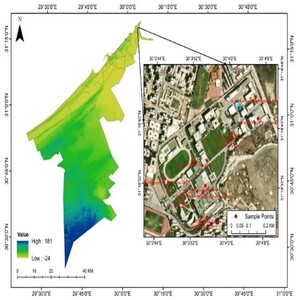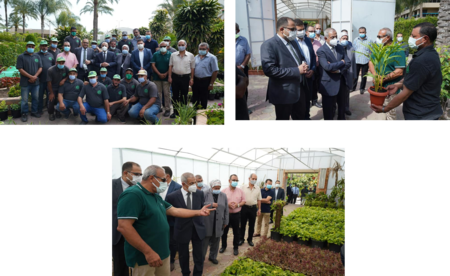
AASTMT practices sustainable water management practices at AASTMT, focusing on groundwater extraction, rainwater harvesting, and innovative pilot projects.
As part of the sustainable infrastructure design for the AAST Al Alamein Hospital, the latest drainage layout showcases a comprehensive stormwater collection network ensuring efficient rainwater management across the facility. The system integrates rainwater pipes (RW.P), gully traps (GT), inspection chambers (IC), and main manholes (MHC) strategically distributed around key building zones. Stormwater collected from roofs and paved areas is directed through underground pipes sloped at 0.5% to maintain steady flow, eventually reaching the free discharge points positioned along the southern perimeter. Additionally, storm drain connections (S.D.C) link the gully traps to the inspection chambers, facilitating maintenance and monitoring while minimizing the risk of surface flooding. This setup demonstrates AAST’s commitment to sustainable water management and climate-resilient building design.
Stormwater Collection System Implemented at Al Alamein Hospital on AASTMT webpage


Some AASTMT campuses (especially those with large landscape areas) uses underground water extraction for irrigation. The Abukir campus in AASTMT is about 25-acre of landscape area that is mostly gardens. In that area, palm trees as well as the green land cover are irrigated by borehole wells of groundwater distributed as shown in Figures. Locations and Coordinates of the Borehole Wells are shown below. Water is extracted through deep wells using mechanical drilling, and submersible pumps are used to draw groundwater. The depth of each well is 15 meters, each is equipped with the following:
Underground water is utilized to cover all irrigation needs for all green areas in AAST as well as for filling up fire protection water system. Underground is carefully monitored and analyzed monthly to make sure that water quality meets irrigation specifications. The amount of underground extracted water for the each year is presented in table 1. Underground water is monitored via metering systems monthly and the annual extraction in cubic meters is as follows:
Table 1: Underground Water Extraction Capacity (m3) | ||||
2020-2019 | 2020-2021 | 2021-2022 | 2022-2023 | 2023-2024 |
216,000 | 237,000 | 102,000 | 81000 | 85000 |
Part of the underground water extracted is being treated, utilizing solar energy to power a three-phase pump and an advanced four-stage nanofiltration system. The setup includes JA Solar Mono-455 W photovoltaic panels that capture solar energy, an ABB inverter to convert this power to operate the pump, and the pump itself, which extracts water from the well. The extracted water then passes through the nanofiltration system, designed with four filtration stages to ensure purity, making it suitable for drinking and agricultural use. The nanofiltration approach effectively removes contaminants at a microscopic level, ensuring high-quality, purified water. This solar-powered system is environmentally friendly, reducing reliance on non-renewable energy sources and providing a reliable, renewable method for water purification in remote or resource-limited areas. By combining solar energy with advanced filtration technology, it offers a sustainable, efficient solution for clean water access.








Rainwater is harvested through drainage systems and pipes, redirected to soil, green areas, and landscapes for reuse in irrigation and other non-potable applications. Open drainage channels on public surfaces and walkways guide rainwater to agricultural basins and green spaces, reducing pressure on the sanitary sewer network. A rainwater collection pit, located near the College of Architecture and Computers, channels harvested rainwater to garden pipes for campus landscaping. Additionally, rainwater is collected from greenhouse roofs in the Aquaculture Center and stored in ten water tanks with a 500-liter capacity. This water is used year-round in hydroponic systems and fertilizer production units, promoting efficient water use and supporting sustainable agricultural practices. Some buildings feature sloped roofs designed for optimal rainwater harvesting. Specialized piping systems channel water from roof surfaces to collection points, where it flows through gutters and downspouts into designated storage or usage systems, ensuring effective and sustainable rainwater reuse.
Aquaculture Research Center





Development of an automated and mobile water treatment system using solar-powered reverse osmosis to provide and deliver water to arid and remote areas in Egypt. The desalination unit produces between 1.5 to 3 liters per minute, depending on the salinity of groundwater. This system desalinates water using PV system as a sustainable source of energy
.jpg)


Implementing New Irrigation Systems
President Professor Dr. Ismail Abdel Ghaffar Ismail Farag visited the agricultural plant nursery at the main campus of the Academy in Abu Qir to assess progress and recent developments. During the visit, he inspected newly added plants, as well as new irrigation systems implemented in the general area and new agricultural greenhouses. The President commended the nursery team for their efforts, especially in adopting modern agricultural and irrigation techniques. He expressed hope for continued efficiency and adherence to modern methods in their work.

More information about internally funded AASTMT projects
Internally funded projects within the Arab Academy for Science, Technology, and Maritime Transport (AASTMT) can significantly contribute to research for water reuse in several ways:
Advancing Water Resource Management: The Experience of the MED-QUAD Project
The AASTMT, as the Egyptian partner of the MED-QUAD project, played an active role in transferring innovative cross-border knowledge and skills throughout the project's implementation. Professor Yasser Gaber Dessouky, the Dean of Scientific Research and Innovation and local project manager for AASTMT, expressed satisfaction with the collaborative efforts. He shared the project's achievements at both the European and local levels. Notably, the MED-QUAD project in Egypt adopted the Quadruple Helix approach, leading to significant accomplishments in water resource management and cultural heritage preservation. This partnership has contributed to advancements in sustainable water management, community engagement, and cutting-edge research, showcasing the transformative impact of MED-QUAD on Egypt's water resources and cultural heritage.The SWUAP Living Lab has achieved significant research outcomes, including MSc theses exploring the use of macroalgae as a sustainable bio-adsorbent for dye removal in alignment with Sustainable Development Goals (SDGs). The lab has also focused on spatial-temporal monitoring of groundwater quality, particularly in understanding the impacts of climate change. Collaborative publications in reputable journals like the Fermentation Journal and the Global NEST Journal cover diverse topics, ranging from sustainable biomethane production to the agricultural benefits of zeolite and backwash water. A study submitted to the Global NEST Journal highlights the application of Metal–Organic Frameworks in industrial wastewater treatment. Notably, research findings on the biosorption potential of red algae for dye removal were published in the Scientific Reports Journal, contributing significantly to sustainable water treatment methods. On the other hand, the ARCHEO Living Lab in Egypt utilizes virtual and augmented reality to provide a unique cultural experience for visitors, both physically present and virtually connected, contributing to the Applied Research on Utilization of Cultural Heritage (ARCHEO).
Advancing Water Resource Management: the experience of the MED-QUAD Project
Advancing Water Resource Management: the experience of the MED-QUAD Project

